How to get hens to lay eggs in winter.

If your girls have stopped laying completely and you have had to resort to store bought you can relax, you don't have broken chickens. It is the short days and not the cold that effect egg production.
Hens stop egg production because there are food shortages, less daylight hours in which to eat, winter is not an ideal time to hatch chicks and they need to moult and change their feathers ready for the new year.
Most backyard flock keepers are quite understanding of the egg gap and make plans by having an extra hen or two or storing some eggs from the surplus in summer.
Table of Contents
- Should I force my hens to lay in winter?
- Why do chickens stop laying eggs in winter?
- When do hens stop laying?
- How long do hens stop laying in winter?
- Do chickens and bantams lay eggs in the winter time?
- What are the best winter laying chickens?
- What to feed chickens in winter:
- Ways to naturally increase winter egg production in chickens:
- How can I increase my winter egg production?
- How long does it take boost winter egg production?
- Artificial light for winter eggs:
Commercially egg producers supplement light to 16 hours a day to keep their hens laying. They are generally not too worried about the longevity of their flock though as hens are routinely replaced after they have been laying continuously for 80 weeks or so. Spent hens are removed and fresh stock bought in.
Below: The moult is a classic reason for interruption of a laying cycle.
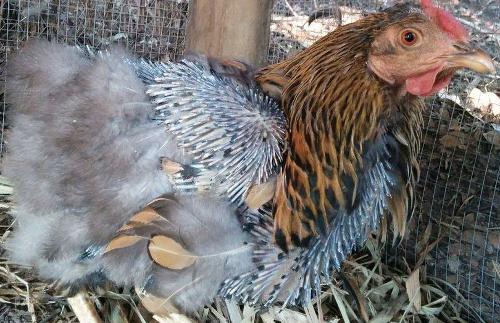
Should I force my hens to lay in winter?
You should not try to force chickens to lay eggs in winter. It is important they rest their bodies, renew the calcium stores in their bones and grow a new set of feathers to guard against the cold.
In winter the hours of daylight are short as compared with the hours of darkness, whereas during the spring and summer seasons the reverse is true. During the winter, therefore, laying fowl must spend 14 hours or more on the roost.
Only 10 or less daylight hours are then left to them in which to exercise and consume sufficient feed to take care of their body needs during the long night period and supply food materials for the production of eggs.
The capacity of a hen's crop is limited and she cannot during the winter months, fill her crop before going to roost with much more than enough food to nourish her body during the long hours of darkness. Very little is left to be manufactured into eggs. The result is that egg production in the winter is greatly reduced as compared with other seasons of the year.
Extended experiments and field observations have demonstrated that artificial lighting will stimulate egg production provided the flock is intelligently fed. By increasing the light hours to compare with spring and summer conditions, poultry are given more time to exercise and eat and less time is spent on the roosts.
Why do chickens stop laying eggs in winter?
Chickens are light sensitive or photo responsive birds and only produce eggs when the conditions are right for successful reproduction. Even though we have been selectively breeding them for hundreds of years this light sensitive trait remains.
The cold has very little to do with whether or not chickens lay eggs although snow on the ground can effect their ability to find food.
Once the amount of daylight starts to fall below 12 hours, it signals to the chicken that it’s time to moult. They shed old feathers and grow new ones and this is an energy intensive process that disrupts the egg laying cycle and can stop it completely.
Below: Chickens don't really like snowy winters.
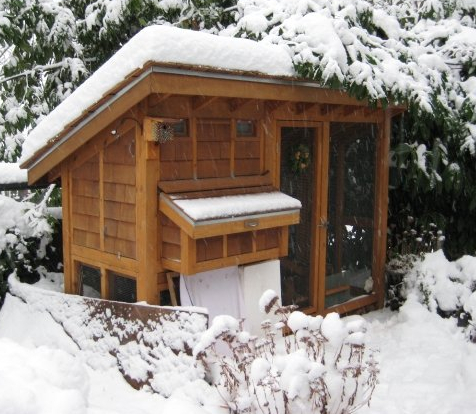
Two glands, the pineal and the hypothalamus, both situated in the chickens’ brain send signals out to the hens body. The hypothalamus regulates growth and reproduction and the pineal gland regulates the circadian rhythm or the internal body clock. The term circadian comes from the Latin circa, meaning "around", and diēm, meaning "day".
Decreased daylight hours stimulate the production of melatonin, even a totally blind chicken will still sense the changing seasons. The processes have evolved to protect the bird and make sure they don't do anything daft like trying to raise a brood in winter when feed is scare and the temperature is low.
If your egg production has decreased and it is not the moult or short days that is responsible then see this article why have my hens stopped laying.
Not all of your birds will stop laying, but the daily output will be significantly less.
When do hens stop laying?
Laying slows with less than 12 hours of daylight and hens tend to stop laying with less than 10 hours of daylight.
Where I live my chickens slow their laying rate during October and stop laying regular eggs in November as the daylight hours drop below nine and a half. Also the days are getting shorter by around 3 and a half minutes a day at this time of year and that really seems to effect the birds a lot.
Some breeds are more seasonal layers than others, I have a French bird, La Bresse Gauloise that defines what seasonal laying is all about. They stop laying completely in October and don't start again until March. My Barnevelders on the other hand produce 2 or so eggs a week all winter from when they have finished their moult all the way through until they ramp up in late February.
The close you live to the equator the longer they will lay for and the further North you live the bigger the egg gap will be.
This trait has been bred out of commercial hybrids to some extent so if a steady supply of eggs is important to you then get a few hybrids.
How long do hens stop laying in winter?
Chickens normally take a break of between 30 and 90 days in the winter. As a rule, but not always, they stop laying during the moult when they change their feathers and don't start again until the days are long enough at the start of spring.
December, January and February are the egg gap in the chickens keepers year. My chickens still produce a few in November and start again as the daylight hours get towards 10 hours a day in late Feb.
As a rough guide expect to have a shortage of eggs for 2 to 3 months if you live North of the Tropic of Cancer or South of the tropic of Capricorn, this would make your days are shorter than 10 and a half hours.
Do chickens and bantams lay eggs in the winter time?
Yes, some do and some don't. I have had hybrid chickens that have laid an egg a day regardless of the season and some breeds like the Barnevelder and other Northern European breeds are well known as winter layers although the rate at which they lay eggs is at least half of the summer rate.
Some of my bantams are less effected by the short days than my bigger girls. I have found that bantams sometimes have a more natural egg laying cycle where they produce 18 to 24 eggs in a row and then have a week or two off before starting again. This is particularly visible in Silkies.
The cycle continues during the winter time just further apart and with less eggs.
What are the best winter laying chickens?
Some chickens are better than others at adapting to the cold, these are generally the large soft feathered types with smaller combs. When I first started keeping chickens I used to think that bantams would struggle in cold weather but I have had them for many years now and they do just as well as my big girls.
Winter hardy chickens that are suitable for cold climates include:
- Barnevelder: Bred in Holland this is a true cold weather breed with a fine or small comb, plenty of feathers to keep it warm and an ability to lay eggs in winter.
- Silkies: Mostly kept as an ornamental breed but instead of a large comb, they have a pom-pom of feathers and therefore will not be as prone to frostbite as other breeds.
- Brahma: Big, solid birds that are docile and quiet. The pea comb means they can endure freezing weather better.
- Orpingtons: Plenty of colours to choose from and large fluffy good natured birds again with a smaller comb.
- Plymouth Rock: This hardy breed was developed in New England with a focus on a solid, dual purpose bird that could survive harshest of winters.
- Wyandotte: Named after the Native American Wyandot tribe and bred for northern chicken keepers they have large dense feathering and a rose comb. Well suited to cold winters.
There are a few others which have proven themselves over the years in cold areas like the Faverolles and the Australorp.
Chickens that do not do so well in cold climates include the hard feather Asiatics, Frizzles and true bantams like the Serama. Old English game may also suffer because of the long legs.
What to feed chickens in winter:
I often get asked questions like "What foods increase egg production in chickens?" and "should you keep feeding layers pellets or mash in winter?"
Backyard flock keepers often find themselves wondering if they should still be feeding layers ration to birds that are currently not producing eggs or if there is something they are missing from the feed that is stopping them laying.
Below: Avoid frozen eggs.
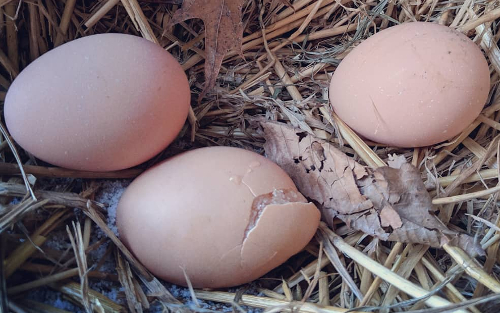
You may have read that layers feed contains a lot of calcium, which is true, and can be bad for birds that are not in lay. This is also true to some extent but cockerels eat layers ration all their lives and it has little effect on their long term health.
You should start feeding layers feed 2 to 4 weeks before the chickens are expected to start laying and the extra calcium in the feed will help your flock recharge it's calcium reserves during the moult and the winter break.
Layer feed should be you default always available chicken feed. Supplement with high calorie, high fat snacks in winter.
Once your chickens have finished the moult extra protein is not required, anything more than 16% of the diet is a waste of expensive feeds.
You can feed a mix of 50% layers and 50% growers or chick feed in winter but the reality is that a handful of shelled sunflower seeds is probably the best mix of calories and protein.
Ways to naturally increase winter egg production in chickens:
It is natural for chickens to take a break from laying eggs, it is a time for renewing the feathers and restocking the resources ready for the next years laying season. There are a few ways to naturally boost egg production and encourage your hens to lay in winter.
- Get your flock up at first light with warm feed. It could be boiled wheat or barley or hot mash or a mix of both of these. Allow it to cool to around 35C or 95F. It should be around 30 minutes before the normally get up and you will need a bright lantern.
- Add DE or Diatomaceous earth to this first feed at a ratio of 2% to make sure they are getting the minerals they need. I also add seaweed flakes which are rich in nutrients at 1%.
- Sprout some what or barley seeds to provide fresh greens or hang a cabbage in the run for them to peck at.
- Add some shelled sunflower or safflower seeds to the diet. Shell on sunflower have too much fibre and the husks are difficult to digest. This is for extra calories and protein.
- Give them a late afternoon feed of whole grains to make sure the crops are full when they roost.
- Invest in a couple of fresh pullets every year. Time it so that their (POL) Point Of Lay is late summer.
These tips are not for forcing your chickens into lay and are more about making sure the hens are well fed and in tip top condition so as they can get laying again as soon as the days begin to lengthen.
Below: Sprouting seeds for fresh greens will help keep the chickens in tip top condition.
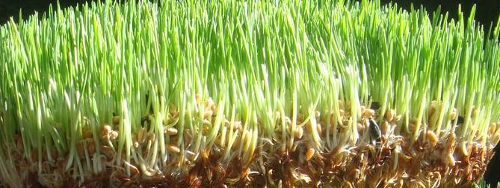
Winter access to water is something that is often overlooked. Even a 12 hours without water will effect laying hens.
Below: Try this for to stop the water freezing.

Its a light bulb inside a hollow brick with a solid top.
How can I increase my winter egg production?
If you want to keep up egg production, you need light, not heat. Chickens as a rule do not need heat unless the temp is continuously below 0C or 32F and even then its is more about keeping the eggs from freezing rather than warming the birds. They are more than happy in the cold weather.
Below: Only add heat if the weather is extremely cold.
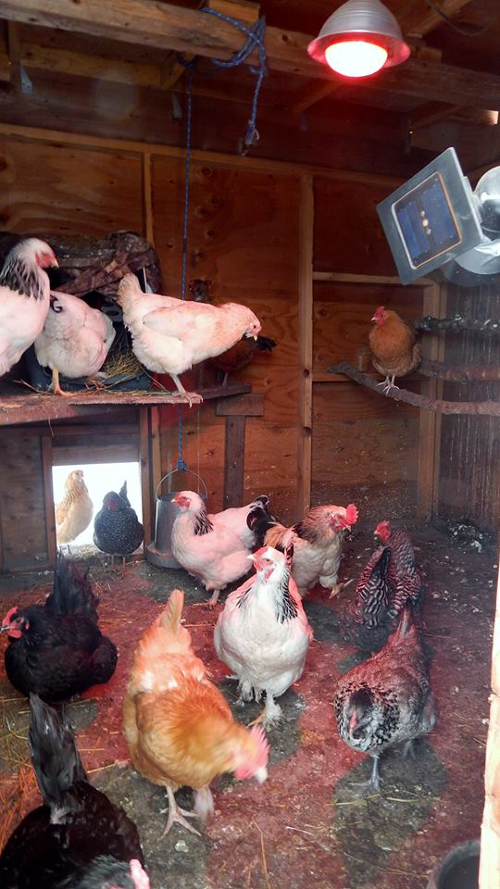
Just make sure it's above freezing and draft free. The warmth will of course create moisture so you have got to make sure it has good ventilation. Other than that, you're gonna want to install a light as they need 10-12 hours of light a day to pop out an egg.
How long does it take boost winter egg production?
It takes 3 weeks at least to see results. Even with adding artificial lighting it is likely to be 2 weeks before the hens come back into lay.
Changes to routine should be made gradually, birds can be shocked by sudden changes or moves.
Artificial light for winter eggs:
The most important part of using artificial lighting with chickens is to use it to get them up in the morning and allow them to roost naturally at night. Lighting a hen house in the evening will leave chickens stuck on the floor in darkness when the lights suddenly go out.
You should not light up birds in winter that have been laying all summer, they do need a break. Winter laying birds will go through an early moult from late spring.
Purpose: The use of artificial lighting of poultry houses is to increase winter egg production. It was first used on the assumption that fowls do not require more hours of rest in winter than in summer and that if artificial lighting were used in winter to produce similar conditions of daylight and darkness as exist in spring and summer and increased production ought to result.
Below: Two small lights are normally sufficient for the average backyard flock.

Value of Artificial Lighting: Investigations conducted at this and other stations have shown that winter production can be increased to as high as 50 or 60 per cent by artificial lighting. The hens begin to respond to such lighting within a week or ten days and the full effect is obtained in about three weeks. A maximum production can then be expected to continue into early March. At that time there is likely to occur a slump in egg yield, which may be accompanied moult lasting from two weeks to more than a month.
Artificial lighting appears to increase winter production at the expense of spring production but the annual production of the flock is not necessarily increased. The principal value of this practice is that it induces an increased production in winter when eggs are high in price, hence without any increase in annual production, artificial lighting will result in a greater money return.
Effect on Pullets and Hens: It has been assumed that a laying hen does not need any more sleep and rest in winter than in summer to keep in good health and the only reason for her spending a longer time on the roosts in winter is because there are more hours of darkness.
Experiments and practical experience seem to prove quite conclusively the soundness of these assumptions because the use of artificial lighting for fourteen hours a day has not been found in any way injurious to a hen's health and vigour. It simply exerts a stimulus on production by lengthening the working day so that the hen can eat and exercise more. It does not over stimulate or force in the sense that a drug does. It is, therefore, not injurious to either pullets or hens and there should be no ill effects carried over from year to year.
Effect on Breeding Hens: The consensus of opinion among breeders and investigators is that it is desirable to use artificial light only with pullets and hens producing eggs for market and not with breeding flocks. It is held that if the breeding fowls are allowed to build up their strength through the winter period in preparation for a large yield of hatching eggs in spring, much better hatches and stronger chicks will be obtained because their vitality has not been reduced by a rather long period of heavy production preceding the hatching season.
But if lights are used with the breeding hens, they should not be started until after the birds have entirely finished the moult and should not be turned on before 5 a.m. daily, i.e., lighting should be used in greater moderation than with flocks producing market eggs.
In hatching tests made of eggs set between December 20 and March 20, breeding flocks that were given artificial light from 5 a.m. to daylight each morning beginning December 1, gave 87 per cent fertility and 52 per cent of all the eggs set hatched, whereas flocks that were given no artificial light gave 96 per cent fertility and 61 per cent of all eggs set hatched.
Source of Light: Electric lights have been found most convenient and are the least dangerous from the standpoint of fire hazard.
Amount of Light: Poultry houses should be supplied with sufficient illumination to amply light the mash hoppers and scratching floor so that the fowls can readily see to scratch the grain out of the litter and eat from the hoppers. The use of reflectors will prove of great value in concentrating the light on the floor where it is needed.
One twenty-five watt lamp, equipped with a metal shade should be sufficient for sixty square feet of floor space.
Colour of light: Red is best, followed by yellow. The brilliant white of mercury vapour lamps should be avoided.
The size and interior arrangement of the house will determine the location of the lights to obtain the most effective illumination.
They can be most conveniently hung six feet above the floor where they are out of the way and least liable to be broken.
When to Use Lights: The use of artificial lighting may begin as early as October first and should be discontinued in the spring when day breaks sufficiently early to render lights of no further value in stimulating production. In trials it has been found that the natural stimulus on production due to the opening of the breeding season and the lengthened period of daylight makes artificial light of practically no value after March first.
When beginning the use of artificial lighting in the fall, the lamps should be lighted fifteen minutes before daylight for the first three days and then the time advanced by five or ten minute periods daily until the hour is reached at which they are to be regularly used.
In spring the lights should be gradually discontinued in the same way, beginning the latter part of February.
Installing Electric Lights: If electric lighting is to be used only in the morning, the wiring should be done in the usual way, but if night lighting is used, provision will have to be made to dim the lights just before they are turned off each night in order to get the birds upon the roosts. Two simple systems of dimming can be used and an electrician can advise how to install either system.
Time Switches: Electrically operated time switches can be purchased which will automatically turn the lights on and off at set times, and dim these lights in any way desired, depending on the construction of the switch. Such devices are quite costly, however, and for morning lighting, a home-made time switch such as is described below will prove just as satisfactory. For night lighting the switches can be readily operated by hand.
This switch will turn the lights on but will not turn them off. When morning lights are used, the turning off of the lights shortly after daybreak is entirely a matter of economy as they are then no longer of any value.
Feeding: Since the effectiveness of artificial lighting is due primarily to feeding and exercise, best results can not be expected unless the poultry keeper takes the opportunity afforded by the use of lights to feed his hens to the best advantage.
Extending the working day, without keeping the hens busy scratching and eating so as to send them to bed with full crops, cannot be expected to bring results. Bringing them off the roosts at 4 :30 a.m. without having a good feed or grain in the litter for them to scratch out, will not prove of much value. They must be kept busy and they must be well and skilfully fed.
